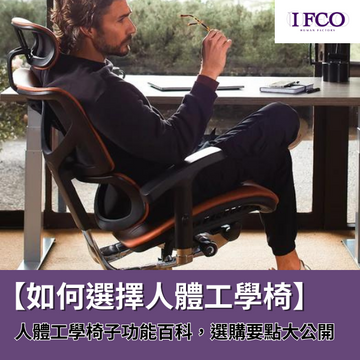【How to Choose an Ergonomic Chair】Comprehensive Guide to Ergonomic Chair Features
by Samuel Sun on Dec 12, 2023

Long Hours of Work Are Damaging Your Body
With the fast pace of modern life, we are spending more and more time sitting at our desks. According to a report by the Mayo Clinic, prolonged sitting in poor posture can lead to various health issues, including musculoskeletal disorders and chronic pain. Your body is highly sensitive to prolonged periods of improper sitting, which can cause damage. Maintaining the same position for extended periods, especially in incorrect posture, puts excessive pressure on your muscles, bones, and joints, resulting in fatigue, stiffness, and discomfort.
When you spend long hours sitting at your desk, you may experience the following problems:
-
Neck and shoulder pain: Incorrect posture can lead to muscle tension and increased pressure in the neck and shoulders, leading to pain and discomfort.
-
Lower back pain: Prolonged incorrect sitting posture can put strain on the lower back, resulting in back pain and lumbar disc issues.
-
Muscle tension and fatigue: Improper sitting posture can cause certain muscles to remain tense for prolonged periods, leading to muscle fatigue and discomfort.
-
Circulation issues: Prolonged sitting can result in poor blood circulation, increasing the risk of deep vein thrombosis.
Why Do You Need an Ergonomic Chair?

The advent of ergonomic chairs is to solve these problems. These chairs usually have adjustment functions, which can adjust the height, angle and support position according to personal needs to ensure correct sitting posture and best support. For example, the adjustable headrest can relieve neck pressure and provide proper support for your head. The design of seat and back support helps to maintain correct spinal alignment and reduce pressure on the back and waist.
Using ergonomic chairs can help improve sitting posture and reduce discomfort and pain. These chairs are designed to provide comfort and support, promote correct posture, and reduce stress and burden on the body. Choosing the right ergonomic chair for you is an important step to protect your health. It can help you stay comfortable and healthy when working long hours or sitting.
The design of ergonomic chairs aims to provide the best support and comfort to relieve stress and fatigue of the body. Ergonomic chairs are designed according to the structure and movement principles of the human body to ensure the correctness of sitting posture and reduce the burden on the body. Provide the best support, comfort and adjustability to relieve stress on the body and prevent health problems. Choosing the right ergonomic chair for you will have a positive impact on your health and comfort.
How to choose an ergonomic chair?
1. Seat height adjustment
For best flexibility, the chair's height range should be slightly lower and slightly higher than your ideal height. Many ergonomic office chairs offer pneumatic height adjustment so you can easily adjust the seat height while seated. Adjusting your office chair to the correct height reduces pressure on your knees and lumbar spine. You should adjust the seat so that your knees are slightly lower than your hips, your thighs are almost parallel to the floor, and your feet are flat on the floor.

2. Seat width
The seat width should be at least one inch (2.54 cm) wider than your hips. On the other hand, it should not be too wide, and the user should be able to place their arms naturally on the armrests without having to stretch out. For heavier users, weight capacity is not the best criterion for choosing a chair, as it is just a safety rating. Both seat width and weight capacity must accommodate the user. Your chair needs to fit your body. In addition, the choice of seat cushion is very important for sitting for a long time. Choosing a seat cushion with proper filling and support can relieve pressure on the buttocks and thighs and provide a comfortable sitting posture. The depth and width of the seat cushion should be sufficient to accommodate the user and provide adequate support.

3. Seat depth adjustment
The seat depth is correct when you can insert 2-4 fingers between the back of your knees and the front of the seat. Proper seat depth adjustment allows the user to fully recline in the backrest, conforming to the body's curves, while utilizing the backrest's lumbar curve design. There are generally two types of seat depth adjustments, seat sliders and back depth adjustment. Seat sliders are controlled by a lever on the seat and allow the seat to be slid forward or back while seated. Back depth adjusters are usually a knob on the backrest that moves the back, this adjustment is harder to adjust while seated and may require assistance, making it better suited for chairs that will have a single user.

4. Choosing a chair base
The chair base controls how the seat and back move and is usually adjusted with a lever under the seat. Some models may offer multiple base options for the same chair. The two most common and popular bases are:
Multi-function base: This base is favored for its wide range of adjustability. It allows the user to adjust the seat and back angle independently, with independent control over the tilt function. This means you can lock the chair in multiple different positions to suit your needs. Multi-function bases typically recline from the center of the seat. This base is often considered the most ergonomically supportive option. (Such as best-selling Ergohuman 2.0 (Elite) Ergonomic Office Chair, Rioli Ergonomic Office Chair (R30) and ES9-SPINO Ergonomic Office Chair)
Synchronous tilt base: A synchronous tilt mechanism links the seat and back so that they recline together as you lean back. Typically, the back reclines two degrees for every one degree of seat tilt. Synchronous tilt bases offer less adjustability than multi-function bases and are therefore ergonomically inferior. Chairs with synchronous tilt bases should have a waterfall front edge or flexible front edge seat to avoid pressure on the back of the thighs when reclining.

6. Backrest angle adjustment
This will also help the chair to fit your body type. The upper backrest supports the weight of the upper back, thereby reducing the burden on the lower back. Many chairs have a backrest angle lock adjustment, allowing you to find the most comfortable angle. The pressure on the lumbar discs is lowest and the back muscles are most relaxed at a backrest support angle of 110°-130°. People usually prefer a reclining posture. For those who sit at a desk for long periods of time, the reclining or tilting function is an important consideration. These features allow you to adjust the tilt angle and position of the chair to suit different work needs and physical conditions. The reclining function allows you to adjust to a comfortable angle when you need to rest or relax, reducing pressure on the spine and muscles. The tilt function allows you to adjust the angle of the chair when you need to lean forward, so that you can better perform specific work tasks, such as using a computer or reading documents.

7. Backrest tilt tension adjustment
Backrest tilt tension adjustment is an important feature of ergonomic chairs. This adjustment allows the user to customize the amount of force required to recline the backrest according to their body weight, achieving the most comfortable sitting posture. Different body weights have different force requirements for the backrest, so this feature allows each person to make personalized adjustments according to their own needs. By adjusting the tilt tension of the backrest, you can control the recline angle and resistance of the backrest. If you prefer a slightly reclined sitting posture, you can increase the tilt tension so that the backrest provides more support, making you feel more stable. Conversely, if you prefer a more relaxed sitting posture, you can reduce the tilt tension, making it easier for the backrest to recline. The benefit of this feature is that it can relieve pressure on the back and spine, and provide better support. Proper backrest tilt can evenly distribute the body's weight, reducing pressure on specific areas, thereby reducing discomfort and fatigue caused by prolonged sitting.

8. Lumbar support
8. Lumbar support
When a normal person sits, the lumbar spine has a natural anterior convex curvature. When you sit on an ordinary chair and reach out to touch the waist, you will feel an empty space that cannot fully contact the back of the chair. In this way, when sitting for a long time, the muscles of the waist must be constantly用力. Therefore, a suitable ergonomic chair must have proper lumbar support at the fourth and fifth lumbar vertebrae, and the thickness of the lumbar support is preferably about 5 cm and the height is about 10-18 cm. However, if the support point is too low, the spine may arch backward frequently, causing pain and discomfort. Therefore, it is best for the chair's lumbar support to have a spring function and adjustable height, so that it can move accordingly as the human back moves in and out. In addition to these functions, there are currently products on the market that allow the lumbar support spring to adjust the softness and hardness (such as the Ergohuman 2.0 (Elite

9. Adjustable armrests
Choosing the right armrest design is also important when choosing an ergonomic chair. The armrests should provide comfortable support and fit your body size and work needs. The best armrest design is one that is adjustable in height and width so that you can customize it to your needs. The armrests should be able to accommodate your arms so that your arms and shoulders can rest naturally and comfortably on the armrests without causing any pressure or discomfort. Additionally, flip-up armrests allow users to move them out of the way when they don't need them (such as the ES9-SPINO Ergonomic Office Chair). Ideally, armrests should be adjustable in both height and width to allow for a more personalized fit. Swivel armrests are also a useful feature as they will allow some users to better adjust the armrest position for support while typing (such as the ES8 - SERTON Ergonomic Office Chair).

10. Stable wheelbase and high-quality wheels
The chair base should have at least five support legs to ensure that it does not tip over easily when the user leans back. These support legs are evenly distributed around the base, increasing the stability and balance of the chair. When you lean back in the chair, you want to feel secure and supported, and this requires a solid base structure to support you. In addition to a stable base structure, high-quality wheels are also an important consideration. These wheels should be able to roll freely on various floor surfaces, allowing you to move around your office or home with ease. High-quality wheels will provide smooth and effortless rolling without getting stuck or scratching the floor. Suitable for hard floors such as tiles, wooden floors or composite floors, ensuring the best rolling effect of the wheels on different floors while protecting the floor from damage. The thoughtful design takes into account different usage environments and floor materials, providing greater flexibility and adaptability.

11. Adjustable headrest
Adjustable headrest is an important feature of an ergonomic chair. The presence of a headrest provides additional support for your head, reducing the weight on your neck. This is especially beneficial for those who spend long hours sitting and need to maintain a seated position for extended periods. The headrest offers extra comfort and support, helping to alleviate pressure on the neck and shoulders. When sitting in a chair, the neck often bears additional weight, especially when tilting the head or maintaining the same position for a long time. This can lead to neck fatigue, stiffness, and discomfort. The presence of a headrest provides proper support, helping to reduce the burden on the neck and allowing you to maintain a more comfortable sitting posture.
For those with neck issues or prone to cervical discomfort, it is highly recommended to purchase a chair with an adjustable headrest. Such a chair can be adjusted according to individual needs to ensure optimal support and comfort for the head and neck. The height and angle of the headrest can be adjusted to accommodate different heights and personal preferences.

12. Try Sitting Before Purchasing:
If possible, try sitting in the chair and evaluate its comfort and adjustability before making a purchase. Trying the chair in person is a crucial step. This ensures the comfort and suitability of the chair. Sit in the chair and feel the cushion, backrest, and support, checking if they align with your personal preferences and needs. Everyone has different body types and preferences, so trying the chair can help you determine if it suits your needs. IFCO's ergonomic chairs offer a wide range of adjustment features to protect your spine and lumbar, correct your posture, and ensure a healthy working environment. You are welcome to visit IFCO's showrooms in Kwun Tong, Sha Tin, or Jordan for a test sit.

Conclusion
In conclusion, choosing an ergonomic chair that suits you is crucial for protecting your physical health. These chairs are designed to provide optimal support, comfort, and adjustability, reducing body pressure and preventing health issues. Selecting a high-quality ergonomic chair can help improve posture, reduce discomfort and pain, enhance work efficiency, and improve quality of life. Remember the above purchasing points and make wise choices when buying an ergonomic chair, caring for your own health. In addition to choosing a suitable ergonomic chair, we should also cultivate good sitting posture habits. Regularly stretch and move your body to avoid maintaining the same position for a long time. Establish a habit of standing or taking intermittent standing breaks to relieve pressure on the body. Additionally, moderate exercise and core muscle strengthening exercises can help increase body strength and flexibility.
Finally, we should always pay attention to our body's condition and be aware of any discomfort signals it sends. If you experience persistent pain or discomfort, seek advice from healthcare professionals to determine the root cause and take appropriate treatment measures.



